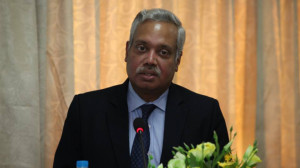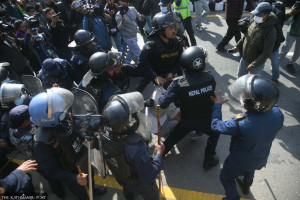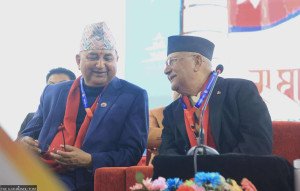National
Lower revenue collection raises questions about health of economy
Officials say liquidity crunch and sluggish capital spending slow down economic activities but tourism hopes are high.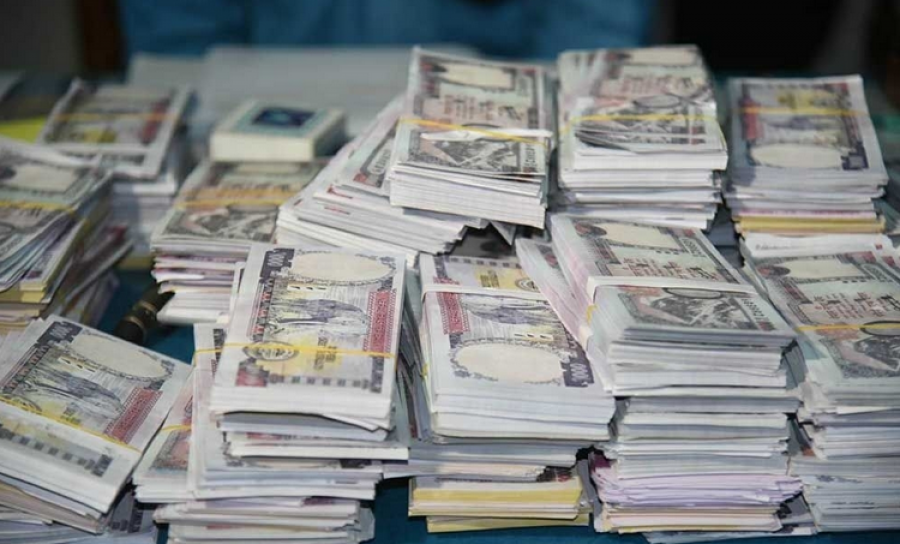
Prithvi Man Shrestha
Tax authorities have failed to meet the revenue collection target in the first nine months of the current fiscal year, raising the question if internal economic activities have also slumped along with worsening indicators of the external sector of the economy.
The external sector of the economy (international economic transactions) is facing a crisis due to falling remittances, rising imports, soaring balance of payment deficit and depleting foreign exchange reserves, according to Nepal Rastra Bank statistics.
Internal economy is being affected by a shortage of loanable funds in the banking system with firms failing to get loans to start or boost their businesses, according to officials and experts.
According to the Inland Revenue Department, it failed to meet the revenue collection target by over Rs32 billion by the third quarter of the current fiscal year that began in mid-July 2021.
“Our target was to collect around Rs375 billion but we could only collect around Rs343 billion,” said Ritesh Shakya, director general at the department.
“Targets were not met in the areas of value added tax (VAT), income tax and tax on interest of banks and financial institutions.”
Inland revenue offices under the department collect taxes from individuals and firms engaged in economic activities within the country’s borders.
According to Shakya, two factors could be responsible for the lower revenue. “One is continued sluggish capital expenditure, which affected the VAT liability,” said Shakya. “And the liquidity crunch in the banking sector has affected economic activities.”
VAT has a good share in tax revenue, but the government’s failure to expedite capital spending affected construction activities in the country. As of April 29, capital expenditure of the government stood at 28 percent of the allocated capital budget, according to the Financial Comptroller General Office.
All banks and financial institutions have reduced their lending amid the liquidity crunch in the banking system.
According to the Nepal Rastra Bank, the average credit-to-deposit ratio of banks and financial institutions is over 90 percent and they are supposed to bring it down below 90 percent by the end of current fiscal year as per the central bank’s directive. So, the banking sector has been reluctant to lend on a large scale in recent months.
“We have been very selective in providing loans owing to the liquidity crunch,” said Sunil KC, chief executive officer of the NMB Bank. “We have prioritised lending to small and medium enterprises with amounts in the range of Rs5-Rs20 million.”
He said that the bank has been able to make additional lending based on loan recovery. Last week, a top Rastriya Banijya Bank official also told the Post that the state-owned bank has confined its lending to a select few sectors.
“We have stopped providing loans under all other headings except for concessional loans and productive sector loans,” Kiran Kumar Shrestha, the chief executive officer of the state owned bank told the Post.“Even under the productive sector category, we are providing loans only for agriculture and tourism.”
Industrialists say that the failure to get loans from the banking sector has badly affected economic activities.
“Demand [from traders] for non-essential items has decreased sharply due to the banking sector’s failure to finance their purchases,” said Shekhar Golchha, president of the Federation of Nepalese Chambers of Commerce and Industry. “The government gets most of its revenue from non-essential items and it is natural that the revenue has been affected due to the liquidity crunch.”
Its impact could be seen in the economic growth this fiscal year. The government had set the growth target at seven percent for the current fiscal year 2021-22. But, a new report of the International Monetary Fund released on Tuesday has projected Nepal’s economic growth in the current fiscal year to be at 4.1 percent.
“I had expected an economic growth of 6-7 percent in the current fiscal year before the liquidity crunch hit but achieving the target now looks impossible,” said Golchha.
However, a senior central bank official disagreed with Golchha’s assessment that the liquidity crunch was responsible for the ongoing slump in economic activities. “There are only 1.7 million borrowers of bank loans against the population of nearly 30 million. It means, borrowers cover a small fraction of the total economic activities. So, we cannot say that economic activities have slumped sharply,” said Prakash Kumar Shrestha, chief of the economic research division at the central bank.
He, however, admitted that the liquidity crunch had a partial impact on economic activities. Irrespective of the impact of the liquidity crunch and low capital expenditure, one sector, the most hit by the pandemic, tourism, is showing signs of gradual recovery.
Nepali hotels on Tuesday decided to scrap the uniform payout structure and pay their employees according to their pay grades in a sign that tourism is bouncing back in the Himalayan republic.
To avoid lay-offs, hotels had introduced a policy of paying an equal minimum amount to all employees–from front office workers to general managers–in July 2020.
“Occupancy rate of hotels has gone up, domestic airlines are fully packed, the Tribhuvan International Airport is operating 24 hours a day and this all suggests tourism is in a recovery mode,” said Shrestha.




 7.12°C Kathmandu
7.12°C Kathmandu

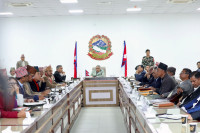



.jpg&w=200&height=120)

